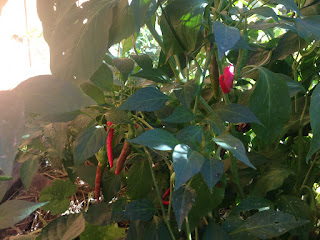Peppers
The peppers have done awesome this year. The plants are just huge, and still loaded with peppers. Here is what I picked this morning, and there are a lot more that I need to pick before the day is over. I need to figure out what to do with all these!
| hot peppers of 4 different varieties, picked before the freeze tonight. |
I am planning to let the red peppers dry out, and maybe freeze the green one. I may try and pickle the jalapenos too. When I planted these, they grew so slowly at first I thought they were not going to make it. It was only until mid-June that they started taking off, and have grown like crazy. Next time I will thin to fewer plants, since I think it was way too much. I think I will also focus more on sweet peppers, and do much fewer hot peppers.
Pumpkins/Winter Squash
 |
| 2 Sugar Pie Pumpkins, 1 hubbard squash, and 2 spaghetti squash |
Spaghetti squash - I had planted 2 hills, right close to 2 hills of sugar pie pumpkins, right at the back corner of the garden. I think the big issue was lack of space. The plants were too cramped together, so I was not able to get in there and take care of the vines, and bury them as I usually do to promote more rooting. So the Squash Vine borers damaged much of the vines. Much of the original vines were exposed, and since they are much thinner vines than pumpkin vines (reminds me of Acorn squash), they were less resistant to SVB damage. Next time if I plant in the fall, I will maybe plant them about 2 weeks later, and give them much more space. Planning on letting them run underneath the peppers didn't work very good either since the pepper plants were very dense. I just need much more space planned for these.
Pumpkins - My 2 hills ended up producing just 2 pumpkins. I think it was the same issue as the spaghetti squash, not enough space! The vines were way to cramped, and I didn't have a chance to bury them and take care of them as I usually do, so they got attacked by SVB and caterpillars, and later powdery mildew. But thankfully I did end up getting 2 very nice pumpkins.
Hubbard Squash - I got one very nice one. I really hoped to get more, and many of them had nice fruit set, to only stop growing a few days later, and then eventually die off. Same thing happened a couple years ago.
I'm not sure that its normal to have low yields on this, or maybe the Texas weather is not really well suited for these. But these are such cool looking squash, that I still want to keep trying in the future, and will definitely be saving seed from the squash in the picture above. I think as is always the case, these also could have benefited from more space, because it seems only after the vines had gotten to 20 feet long did they start making female flowers.
Pumpkins - My 2 hills ended up producing just 2 pumpkins. I think it was the same issue as the spaghetti squash, not enough space! The vines were way to cramped, and I didn't have a chance to bury them and take care of them as I usually do, so they got attacked by SVB and caterpillars, and later powdery mildew. But thankfully I did end up getting 2 very nice pumpkins.
Hubbard Squash - I got one very nice one. I really hoped to get more, and many of them had nice fruit set, to only stop growing a few days later, and then eventually die off. Same thing happened a couple years ago.
I'm not sure that its normal to have low yields on this, or maybe the Texas weather is not really well suited for these. But these are such cool looking squash, that I still want to keep trying in the future, and will definitely be saving seed from the squash in the picture above. I think as is always the case, these also could have benefited from more space, because it seems only after the vines had gotten to 20 feet long did they start making female flowers.
Beans
I think I timed my pole beans perfectly this year! Last year I was too late and the frost got them before I had significant production, so I planted a few weeks earlier this year (seeded around 8/19). The plants came up and grew well despite the heat, and then started producing well in the early fall. We've had about three or 4 weeks of very good production, but this freeze will most likely do them in. |
| Pole beans growing up fence, next to basil bushes |
Cool Weather Plants
In the previous post I had mentioned the cabbage, spinach and turnips we had just planted. They are doing very well, except for some holes in the turnip leaves. Hopefully the frost will get rid of the bugs doing that,which I suspect are flea beetles, which are a big pest for turnips for me. The cabbage are beautiful, and I can see the leaves are just starting to form heads. The spinach is doing well, but growing much slower than the cabbage. I have a newer patch of cabbage too ( bottom right of picture.)
These can all take frost and freezes fairly well, except if it gets down to the mid-20s, then I'll need to cover them.









































